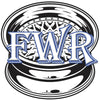-
Chrome finishes on wheels offer a variety of aesthetic and functional benefits, making them popular choices for enhancing the look of a vehicle. There are several types of chrome finishes available, each with unique characteristics. Here's a detailed explanation of the different types of chrome finishes for wheels:
1. Traditional Chrome Plating
Process: Traditional chrome plating involves applying a layer of chromium onto the wheel's surface through electroplating. The process includes cleaning the wheel, applying a base layer of nickel, and then plating with chromium.
Characteristics:
- High Shine: Produces a highly reflective, mirror-like finish.
- Durability: Provides excellent resistance to rust and corrosion.
- Maintenance: Requires regular cleaning to maintain its shine and prevent pitting.
2. PVD Chrome (Physical Vapor Deposition)
Process: PVD chrome involves a vacuum deposition process where the chrome material is vaporized and then deposited onto the wheel. This process creates a thin, durable chrome finish.
Characteristics:
- Eco-Friendly: Less harmful to the environment compared to traditional chrome plating.
- Durability: Highly resistant to peeling, chipping, and corrosion.
- Variety: Available in various shades, including black chrome.
3. Black Chrome
Process: Black chrome is created by adding a black tint to the traditional chrome plating process. This can be achieved through different techniques, including variations in the electroplating process or applying a tinted topcoat.
Characteristics:
- Unique Appearance: Offers a darker, smoky, and more aggressive look compared to traditional chrome.
- Durability: Maintains good resistance to corrosion and wear.
- Maintenance: Requires similar care to traditional chrome but may show scratches more prominently.
4. Chrome Clad
Process: Chrome-clad wheels are made by attaching a plastic chrome cover to an aluminum or steel wheel. The cover is typically fastened or bonded to the wheel.
Characteristics:
- Cost-Effective: Generally less expensive than traditional chrome plating.
- Appearance: Provides a similar look to traditional chrome but may not match the same level of shine.
- Weight: Slightly lighter due to the plastic component.
- Durability: The plastic cover can be less durable and more prone to damage compared to metal finishes.
5. PVD Black Chrome
Process: Similar to PVD chrome, PVD black chrome uses the PVD process with added steps to achieve a black chrome finish.
Characteristics:
- Enhanced Durability: Offers superior resistance to scratches, chips, and corrosion.
- Aesthetic Appeal: Combines the unique look of black chrome with the benefits of PVD technology.
- Maintenance: Easier to maintain compared to traditional black chrome finishes.
6. Hyper Chrome
Process: Hyper chrome finishes involve multiple layers of paint and lacquer over a chrome-plated surface. The process creates a bright, metallic appearance.
Characteristics:
- High Reflectivity: Provides a bright, mirror-like finish with a slight tint.
- Depth and Brilliance: The layered process adds depth and enhances the reflective quality.
- Maintenance: Requires regular cleaning and care to maintain its appearance.
Conclusion
Choosing the right type of chrome finish for wheels depends on various factors, including aesthetic preference, budget, and desired durability. Traditional chrome plating offers classic high shine and durability, while PVD chrome provides an eco-friendly and robust alternative. Black chrome and its variants offer unique visual appeal for those seeking a distinct look. Chrome-clad wheels provide a cost-effective option, and hyper chrome delivers enhanced depth and brilliance. Each type of chrome finish has its unique set of benefits, making it essential to consider the specific needs and preferences when selecting wheels for a vehicle.




